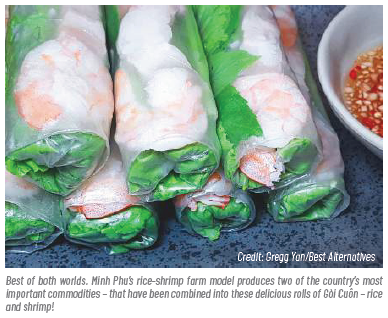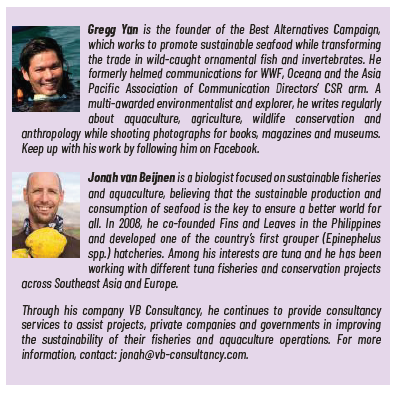Article II 6/2024 - BEST OF BOTH WORLDS: COMBINING RICE AND SHRIMP FARMING IN VIETNAM’S MEKONG DELTA
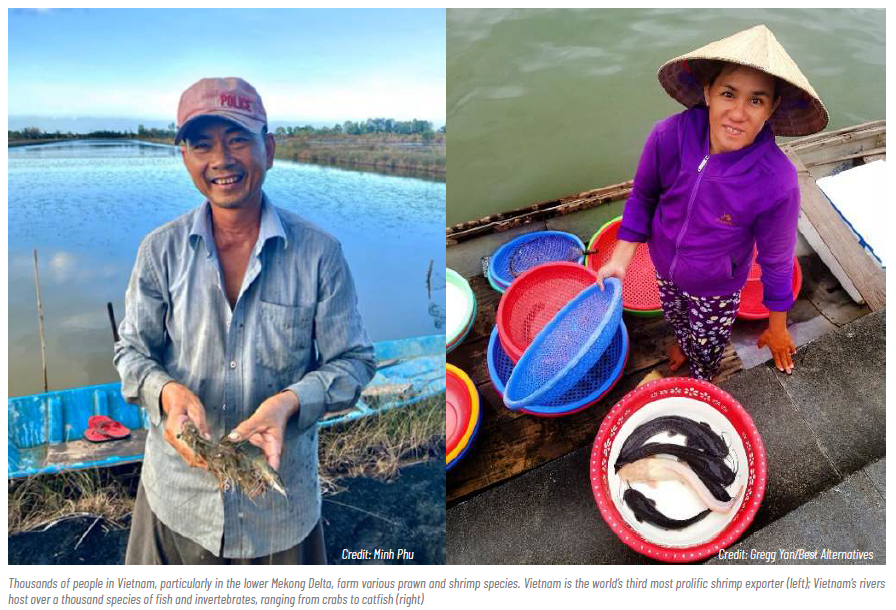
Known by the Vietnamese as the ‘nine-tailed dragon’ after its nine primary outlets, the Mekong is Asia’s equivalent of the Amazon, extending 4 800 kilometres from China, Myanmar, Thailand, Laos and Cambodia, before emptying into the South China Sea through the flatlands of Vietnam. Among the biggest issues faced by the Delta’s residents and farmers is that the area is quite literally sinking to new depths yearly.
In the lower Delta, tides fluctuate by up to three metres. Previously, high tides brought seawater some 20 to 30 kilometres inland. Largely because of subsidence and changing river hydraulics due to sand mining, the amount of sediment in the river is being reduced and the sea is now able to flow up to 70 kilometres inland (Kaveney, et al). In addition, the extraction of too much stored freshwater in underground aquifers leaves vast empty spaces, which can be quickly filled by seawater, particularly in deltas and other low-lying areas near the sea.
“The withdrawal of too much groundwater for irrigation, aquaculture, industry and household usage is causing subsidence, the sinking of land,” explains Steven Starmans, Director of Kim Delta, based in Can Tho, Vietnam. Experts estimate that the Delta is sinking by up to four centimetres yearly. It doesn’t sound like much, but a large part of the Delta lies just one metre above sea level.
Exacerbating this are the relatively long and dry summer months, spurred on by climate change. This generates less physical pressure for freshwater runoff to drive back the influx of the tide. Current estimates peg seawater intrusion to breach 100 kilometres in the early dry season (Eslami, et al), literally ‘salting’ the Delta and posing serious threats not just to aquaculture operators growing freshwater stock like pangasius, carp and freshwater prawns, but also the Delta’s rice paddies, as salinity is lethal to most crops.
A recent study by Vietnam’s Water Resources Science Institute estimated that the Delta is losing USD3 billion yearly in crops due to seawater intrusion, which is corroborated by similar research papers (Can, et al). The biggest losers are the aquaculture, rice and fruit production sectors – each bearing about 30 percent of the loss.
Climate-centric rice-shrimp farming model
The Minh Phu Seafood Corporation is one of Vietnam’s leading shrimp processing companies. It works closely with the government and local farmers to improve local practices and ensure long-term sustainability and food security. The company has been increasingly engaged in exploring extensive shrimp farming systems, developing a working model for natural mangrove-shrimp farming while perfecting its rice-shrimp farming model.
“Simply put, we can farm shrimp during the dry season when seawater intrusion is strongest. Once the monsoon season sets in to inundate the floodplain with freshwater, we can switch back to farming rice. We call this the rice-shrimp farming model,” says Minh Phu CEO Le Van Quang.
The system’s hallmark is to understand the natural movement of water each season to restore productivity in the areas most affected by salt intrusion. Instead of endlessly fighting to keep saltwater away from ricefields, the system just ‘goes with the flow’ and makes the best of the available saltwater.
Understanding the rain and shine cycle
Shrimp, particularly native black tiger (Penaeus monodon), can be raised entirely utilising the rich natural food supply from the decomposing rice plant roots, which serve as temporary homes for a host of aquatic organisms.
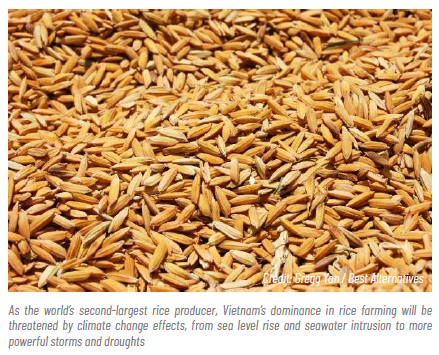
Meanwhile, the high-salt ecosystem kills most rice plant diseases, making it possible to grow rice without pesticides and fertilisers. Two rice varieties are used in this model: ST24 and ST25 which are known to be extra-fragrant and salt-tolerant. The farmers have so far found that rice grown in slightly salty water is tastier and more fragrant.
When the rainy season finally comes and brings in freshwater, the shrimp ponds again transform into lush rice fields. Nutrients, shrimp waste and flocs from the shrimp farming season enrich the fields, forming natural organic fertiliser to supercharge rice growth. The inbound freshwater in turn, kills pathogens from the saline ecosystem, allowing shrimp farming without the need for medication or artificial feed and relying entirely on natural conditions (Adams, et al).
“The cycle of alternating between two water seasons and two contrasting living environments has many advantages, promoting balance and sustainability in farming. Each component serves as both the output and the input for each other within a closed-loop system, optimising resources and material flows,” adds Quang.
An ecological concern is that the brackish water used during the farming of shrimp will increase the salinity of the soil further. However, Quang explains that during the rainy season in the rice-shrimp farming areas, people use a special salt-washing technique that reduces the salinity in the shrimp ponds to zero without pumping in freshwater.
Locals use rainwater to wash the salt away, a practice which is so far working well. Results from water measurements in drilled wells show no saltwater intrusion into groundwater reservoirs. In addition, the company only promotes this farming model in areas that are worst affected by salt intrusion and which would likely be forced into shrimp farming monoculture if the situation would get worse. In areas where the salinity is high year-round, the company promotes its mangrove-shrimp farming model which consists of intensive monoculture using High Density Polyethylene (HDPE) liners and filtration systems to reuse the water. Over 10 000 hectares of mangrove-shrimp plots are in operation, with the figure expected to increase exponentially in the coming years.
The rice-shrimp farming model is now gaining in popularity and the company is testing its efficacy in around 20 000 hectares, aiming to expand to 50 000 hectares within a few years. Its unique, highly adaptive characteristics has made it an environmentally-friendly system that can be field-tested outside the Mekong Delta, particularly in tropical or subtropical areas where seawater intrusion is becoming a problem for rice farmers.
The payoff is around five to eight tonnes of rice and 300 to 1 000 kilogrammes of shrimp per harvest cycle. Annual income from this model ranges from a minimum of USD 9 800 to an average of USD 20 000 and can reach nearly USD 40 000 per hectare with successful cultivation.
The rice is primarily sold locally, with the price of ST24 and ST25 fragrant rice around 80% higher than regular rice. The farmed shrimp fetches a much higher price, with most being exported to sustainability-conscious consumers in Europe and the United States.
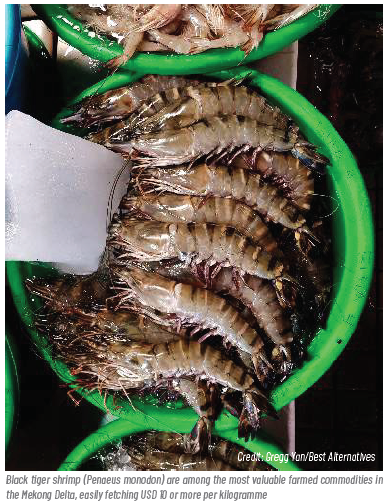
“Minh Phu has been collaborating with the national government and local farmers to implement and develop the rice-shrimp model to achieve ASC/ BAP/ organic and ecological certifications, with the goal of expanding operations throughout the Mekong Delta. This helps our farmers secure higher market prices and better lives for themselves and their families,” concludes Quang. “All we need is more investments to scale up and enhance the productivity of the Mekong Delta, even in the face of climate change and the human-induced challenges the world is facing.”
